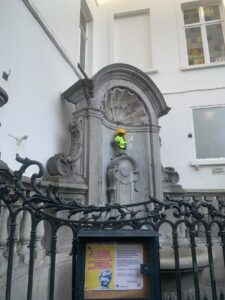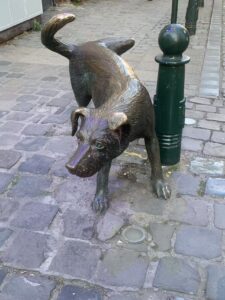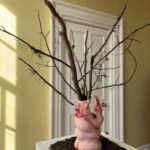On the streets of Europe in April, the air is slightly cool and the sunlight is thin. I traveled all the way north from Brussels, Belgium to Amsterdam, the Netherlands. This journey was originally just a brief escape, but unexpectedly became an extension of my curatorial thinking.
💧 Brussels: Who is watching, Who is being stared at?
Walking on the streets of the old town of Brussels, I was unconsciously attracted by three small statues: Manneken Pis (the peeing boy), Jeanneken Pis (the peeing girl), and the dog version of Het Zinneke Pis not far away. These images may seem funny and cute, but they can’t help but make people wonder: Why would a city sculpture the act of “excretion” so openly?



Among these three images, the tension of gender, power and visibility is clearly visible: Manneken is the male character crowned as the “national mascot”; Jeanneken was hidden behind the iron bars, as if it were a belated and clumsy attempt at equality. And the dog version – without gender, without face, has completely become an anonymous humorous species.
They are very much like “street intervention” in contemporary art, countering monumental grand narratives in an extremely physical way. Standing in front of them, I recalled Laura Mulvey’s “Gaze Theory”, and I was no longer just a tourist but participated in this exchange of “the power to watch”.
The disappointment of Amsterdam: When Museums Turn into consumption mazes
When I arrived in Amsterdam, I walked into the Van Gogh Museum with great anticipation. But unfortunately, the design of the lighting is cold, hard and mechanical. The movement lines seem to have been deliberately compressed for the electronic tour guide service. Even in some areas, the flow of people is blocked, as if one is shuttling through the exhibition of the fast-moving consumer goods industry rather than being immersed in the layer by layer of emotional and brushstrokes.


I began to question: If an art gallery renowned for its “paintings of emotion” still fails to handle the relationship between intimacy and space properly, then as curators, how can we create genuine experiences in the tension between “transience” and “emotion”?
References:
Balsom, Erika. After Uniqueness: A History of Film and Video Art in Circulation. New York: Columbia University Press, 2017.
Balsom, Erika. “Exhibiting Cinema in Contemporary Art.” In Art and the Moving Image: A Critical Reader, edited by Tanya Leighton, 399–412. London: Tate Publishing, 2008.
Bishop, Claire. Installation Art: A Critical History. London: Tate Publishing, 2005.
Mulvey, Laura. “Visual Pleasure and Narrative Cinema.” Screen 16, no. 3 (Autumn 1975): 6–18.









